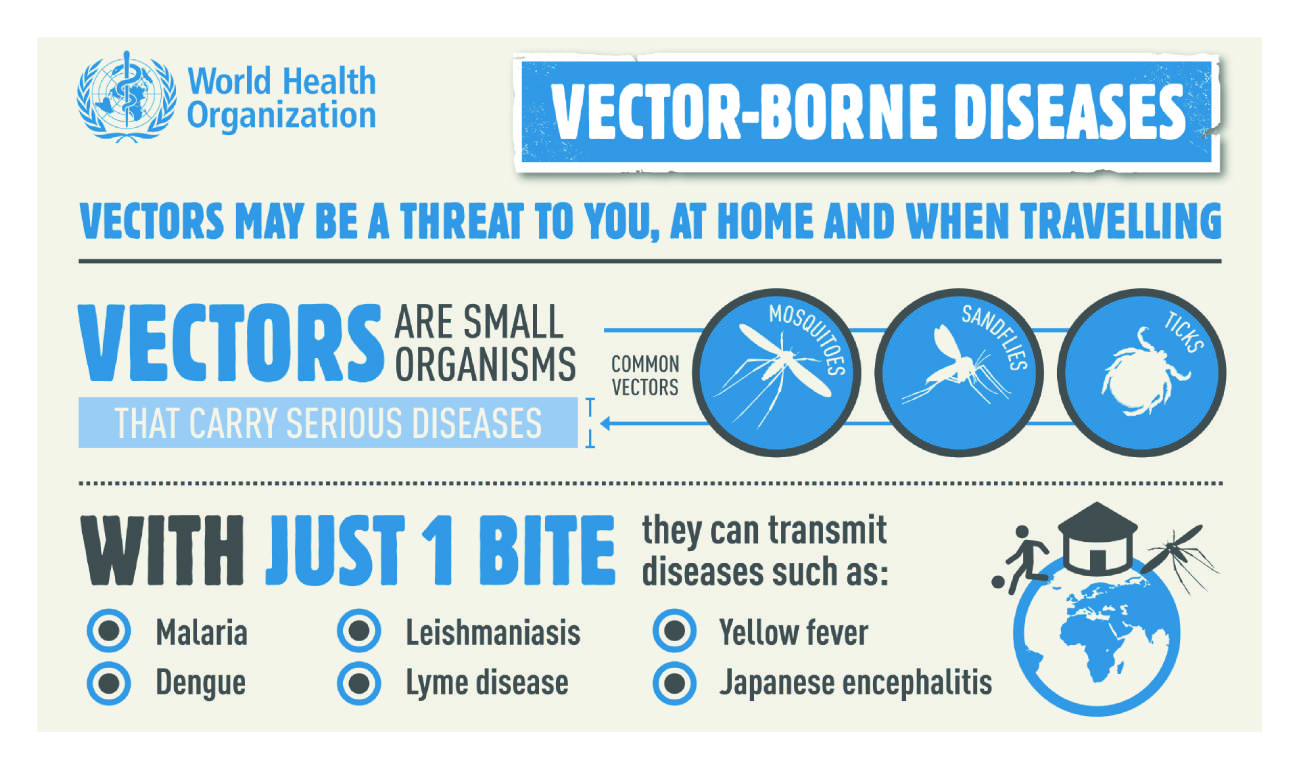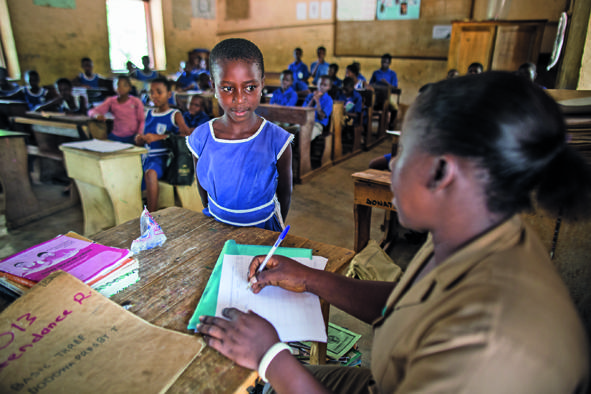This year’s World Health Day on 7 April is devoted to vector-borne diseases. This poster, developed for the campaign, shows three common vectors – mosquitoes, sandflies and tics.
Contraception and human rights
WHO has launched new guidance to help countries ensure that human rights are respected in the provision of contraceptive information and services.
Universal access to reproductive health by 2015 is part of Millennium Development Goal 5 and one of the indicators for measuring progress towards this goal is the extent to which the need for contraception has been met.
The prevention of unwanted pregnancies results in a decrease in maternal and infant deaths and disease.
But this unmet need is great: an estimated 222 million girls and women who do not want to get pregnant, or who want to delay their next pregnancy, are not using a modern method of contraception, the guidance notes.
The 26-page guidance document that was released last month recommends that everyone who wants contraception should be able to obtain detailed and scientifically accurate information, and that a variety of services, such as counselling as well as contraceptive products should be made freely available.
The guidance stresses that age-appropriate sex education programmes for young people, including information on how to use and acquire contraceptives, should be based on sound scientific evidence. Adolescents should be able to seek contraceptive services without having to obtain permission from parents or guardians, and women should be able to request services without having to obtain authorization from their husbands.
http://www.who.int/reproductivehealth/publications/family_planning/human-rights-contraception
WHO finalizes guideline on “free sugars”
This month WHO finalizes revised recommendations on the intake of what are known as “free sugars”, following peer-review by an external expert group and a public consultation last month.
The guideline will provide countries with recommendations on limiting the consumption of free sugars to reduce diet-related noncommunicable diseases, such as obesity and dental caries (tooth decay).
Free sugars include monosaccharides (such as glucose and fructose) and disaccharides (such as sucrose – commonly known as table sugar – and lactose) that are added to foodstuffs by manufacturers, cooks and consumers.
Free sugars also include the types of sugar that are naturally present in honey, syrups, fruit juices and fruit concentrates, but do not include the sugars found in non-refined foodstuffs, such as brown rice or fruit.
Once finalized, the document will be cleared by WHO’s Guidelines Review Committee before its official release later this year.
WHO’s current recommendation, from 2002, is that free sugars should make up less than 10% of total energy intake per day.
The new draft guideline recommends that free sugars should make up less than 10% of total energy intake per day, while a reduction to below 5% of total energy intake per day would have additional health benefits.
In an average adult of normal body mass index and light activity pattern the five per cent of total energy intake is roughly equivalent to 25 grams – or about six teaspoons – of sugar per day.
Many of the sugars consumed today are “hidden” in processed foods. For example, one tablespoon of ketchup contains around 4 grams (around one teaspoon) of sugar and a can of a sugar-sweetened soda drink contains up to 40 grams (around 10 teaspoons) of sugar.
The draft guideline is based on an analysis of all the available scientific studies on the human consumption of free sugars and the effect of reducing or increasing this on weight gain and dental decay in adults and children.
http://www.who.int/mediacentre/news/notes/2014/consultation-sugar-guideline
New WHO standards for influenza surveillance
WHO has released a new set of standards for the surveillance of influenza and other respiratory illnesses for public health authorities.
Global epidemiological surveillance standards for influenza provides new guidance on the collection, reporting and analysis of epidemiological surveillance data on seasonal influenza, along with new case definitions for influenza-like illness (ILI) and severe acute respiratory infections (SARI).
Influenza surveillance has traditionally focused on monitoring viruses and collecting specimens for the development of seasonal influenza vaccines – ever since WHO established the Global Influenza Surveillance and Response System, formerly known as the Global Influenza Surveillance Network, in 1952.
But in recent years, countries have called on WHO to expand influenza surveillance to include more epidemiological data, in line with resolution WHA 64.5 to adopt and implement the Pandemic Influenza Preparedness Framework at the World Health Assembly in May 2011.
The new standards address gaps in global influenza surveillance, including the lack of established surveillance for severe disease in most countries and of an international mechanism for sharing epidemiological data.
The standards were developed following a global consultation in Geneva in March 2011 and subsequent review by surveillance experts and WHO regional offices, followed by a six-month public consultation on the WHO web site. They have also undergone field testing.
http://www.who.int/influenza/resources/documents/influenza_surveillance_manual
http://www.who.int/influenza/surveillance_monitoring/ili_sari_surveillance_case_definition
Some countries are rolling out the human papilloma virus (HPV) vaccine against a sexually-transmitted infection that can cause cervical cancer (see on this page “Vaccines for sexually transmitted infections”. This month’s cover photo shows a school girl in Ghana registering to get the jab.
Vaccines for sexually transmitted infections
More investment is needed in research and development for new vaccines to stop the spread of genital herpes, gonorrhoea, chlamydia, syphilis and trichomoniasis, according to a special issue of the journal Vaccine.
The special issue of the journal appeared last month. It was co-edited by WHO, the United States’ National Institute of Allergy and Infectious Diseases and the United States National Institutes of Health.
“Sexually transmitted infections are a massive health challenge,” said Dr Marleen Temmerman, director of the Department of Reproductive Health and Research at WHO. “First, they are extremely common – more than a million new infections occur every day. Second, most infections don’t show any symptoms so people don’t know they are infected. Third, gonorrhoea, one of the major diseases, is becoming increasingly resistant to the medicines currently available to treat it.”
For example, sexually transmitted infections, such as herpes, can increase the risk of HIV infection threefold or more while mother-to-child transmission of syphilis can result in stillbirth, neonatal death, low birth weight and prematurity, and congenital defects.
Infection with the human papilloma virus contributes to some 530 000 cases of cervical cancer each year, although a vaccine for this has been introduced in some countries, and sexually transmitted infections, such as gonorrhoea and chlamydia, are major causes of pelvic inflammatory disease, adverse pregnancy outcomes and infertility.
“Widespread immunization with safe and effective vaccines could revolutionize the way we tackle sexually transmitted infections,” said Dr Jean-Marie Okwo-Bele, director of the Department of Immunization Vaccines and Biologicals at WHO. “The good news is that the introduction of vaccines to prevent both hepatitis B and human papillomavirus infections shows that it can be done.”
http://www.sciencedirect.com/science/journal/0264410X/32/14
New guidance on health and climate change
A new WHO guidance document, entitled Protecting health from climate change: vulnerability and adaptation assessment, advises countries on what they can do to avoid or lessen the negative health effects of climate change.
These health effects are many. Studies show that climate change alters the number of people affected by malnutrition and vector-borne diseases, and that it alters the nature of some extreme forms of weather, such as heatwaves, floods, droughts and windstorms. The document explains how countries can conduct a national or sub-national assessment of their current and future vulnerability to the health risks that are associated with climate change.
http://www.who.int/globalchange/publications/vulnerability-adaptation
http://apps.who.int/bookorders/anglais/detart1.jsp?sesslan=1&codlan=1&codcol=15&codcch=864
25 April – World Malaria Day
23–30 April – World Immunization Week
17–18 May – Conference hosted by the World Health Professions Alliance entitled Health professional regulation – facing challenges to acting in the public interest, Geneva, Switzerland
19–24 May – Sixty-seventh World Health Assembly
31 May – World No Tobacco Day

 WHO
WHO GAVI/2013/Evelyn Hockstein
GAVI/2013/Evelyn Hockstein